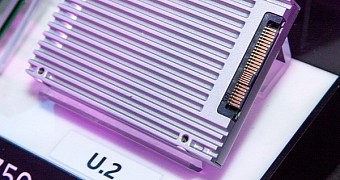It's no coincidence why the PCIe SSDs are a booming industry right now, as we showed during the unveiling of the SandForce 3500 SSD controller and how G.Skill tries to offer a strong competition to Intel's monster 3700 PCIe 2TB series.
Being a market indirectly guided by Intel's righteous hand, the two-lane limit of the SATA Express prompted the industry to quickly move to the 2.5" over the PCIe. It's basically an overpowered SATA Express plugged straight in the PCIe lanes. Together with Intel bringing the SFF-8639 to the client-side with the SSD Intel launch, it became clear that the PCIe trend will grow exponentially to new heights.
However, the nomenclature remained at lab levels as pronouncing a name like SFF-8639 will surely break some tongues, so Intel decided to change it to U.2, as in U(dot)2 not to confuse the public with the famous music band. Also other reasons for changing the name was also to integrate it with another term coined by Intel, M.2 that has already been used in the industry for a couple of years and more importantly both connectors now carry alike naming.
Is it cost-effective as it is fancy?
However, according to Hardwarezone, costs will remain still high as the U.2 cable will carry a number of small shielded cables that will increase the cost over the classical SATA cables. Just as how the M.2 connector can carry SATA and PCIe signaling, the U.2 connector is an extension of the SATA / SAS standard connectors. Also, there are not only 7 additional pins between the repurposed SATA data and power pins, but also an extra 40 pins on the back side. These can carry up to PCIe 3.0 x4 to the connected device.
However, there are some issues. One of the advantages of the SATA Express development was the cable price, which was the same as the ones existing until SATA Express.
It is believed that the U.2 connector will take over the high-end system as it can provide more thermal and memory capacities over the more consumer-friendly M.2 that will probably remain within the more humble specs spectrum because of capacity and heating limits.

 14 DAY TRIAL //
14 DAY TRIAL //